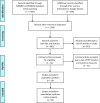Outcomes and Return to Sports Following the Ankle Lateral Ligament Reconstruction in Professional Athletes: A Systematic Review of the Literature
- PMID: 35140851
- PMCID: PMC8789970
- DOI: 10.1007/s43465-021-00532-0
Outcomes and Return to Sports Following the Ankle Lateral Ligament Reconstruction in Professional Athletes: A Systematic Review of the Literature
Abstract
Introduction: The literature on the early reconstruction of severe acute lateral ligament injuries in professional athletes suggests earlier rehabilitation and reduced incidence of recurrent instability. Predicted time to return to training and sports is important to both the athlete and the club and has not previously been reported.
Aims and objectives: The primary aim was to establish the best treatment options available for lateral ligament injury in professional athletes and assess the average time to return to physical training and return to play (RTP). Secondary aims were to find out the rate of return to the pre-injury level of competitive sports and the reasons for delayed recovery.
Materials and methods: We performed a systematic review according to PRISMA guidelines to evaluate the demographics, clinical profile, management, and treatment outcomes. Electronic searches of the MEDLINE, EMBASE, and Cochrane databases were performed. Studies conducted between Jan 2000 and Dec 2020 with articles reporting the ankle lateral ligament reconstruction in professional athletes were included.
Main results: After initial screening, 982 articles were identified, of which, 10 articles evaluating 343 athletes met the criteria and were included for final review. The combined mean age was 23 years with an average follow-up of 58.4 months. After surgery 308 (89%) returned to their pre-injury level of sports, 7 (2%) patients returned to a lower-level sport while the remaining 28 (9%) never returned to play.
Conclusion: Our results provide a guide to predict the expected time to return to play (RTP) after surgical repair of lateral ligament injuries along with associated injuries leading to delayed rehabilitation. Lateral ligament reconstruction is a safe and effective treatment for severe ruptures providing a stable ankle with a mean time of 16 weeks to return to sports. The available studies vary considerably in their metrics used for measuring patient-reported outcomes.
Supplementary information: The online version contains supplementary material available at 10.1007/s43465-021-00532-0.
Keywords: Lateral ankle instability; Modified Broström operation; Professional athletes; Return to play.
© Indian Orthopaedics Association 2021.
Conflict of interest statement
Conflict of InterestThe authors declare that they have no conflict of interest.
References
-
- Barker HB, Beynnon BD, Renstrom PA. Ankle injury risk factors in sports. Sports Medicine (Auckland, N. Z.) 1997;23:69–74. - PubMed
-
- Ferran NA, Maffulli N. Epidemiology of sprains of the lateral ankle ligament complex. Foot and Ankle Clinics. 2006;11(3):659–662. - PubMed
-
- Fong DT, Hong Y, Chan LK, Yung PS, Chan KM. A systematic review on ankle injury and ankle sprain in sports. Sports Medicine (Auckland, N. Z.) 2007;37(1):73–94. - PubMed
-
- Karlsson J, Lansinger O. Lateral instability of the ankle joint. Clinical Orthopaedics and Related Research. 1992;276:253–261. - PubMed
Publication types
LinkOut - more resources
Full Text Sources
Research Materials
Miscellaneous

